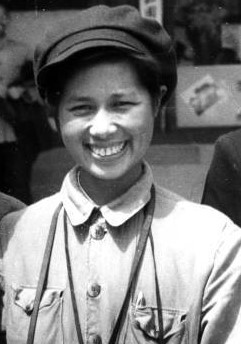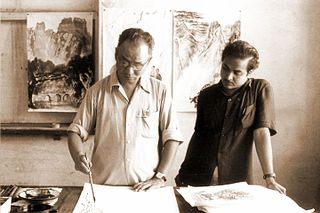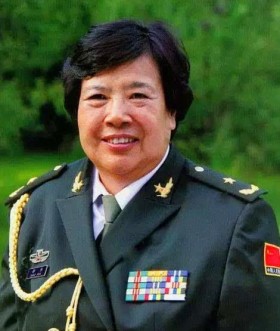This is a list of women photographers who were born in China or whose works are closely associated with that country.
This is a list of women photographers who were born in China or whose works are closely associated with that country.

The Long March was a military retreat by the Communist Red Army from advancing Nationalist forces during the Chinese Civil War in 1934 through 1936.
Photography in China dates back to the mid-19th century with the arrival of European photographers in Macao. In the 1850s, western photographers set up studios in the coastal port cities, but soon their Chinese assistants and local competition spread to all regions.

Zhang Xiaogang is a contemporary Chinese symbolist and surrealist painter. Paintings in his Bloodline series are predominantly monochromatic, stylized portraits of Chinese people, usually with large, dark-pupiled eyes, posed in a stiff manner deliberately reminiscent of family portraits from the 1950s and 1960s. Recently, he also created sculptures, translating for the first time into three dimensions many characters of the sort seen in his "Bloodlines—Big Family" portrait series. These sculptures have featured in many exhibits and continue his work as one of China's leading, and most highly sought-after, contemporary artists.
Feng Mengbo is a contemporary Chinese artist who works mainly in new media.
Tseng Kwong Chi, known as Joseph Tseng prior to his professional career, was a Hong Kong-born American photographer who was active in the East Village art scene in the 1980s. He is the brother of dancer/choreographer Muna Tseng.

Hou Bo was a Chinese photographer who, with her husband Xu Xiaobing, was among the best known photographers of Mao Zedong. Born into a poor peasant family, Hou Bo joined the Communist Party at the age of fourteen and learned photography during the Second Sino-Japanese War in order to present a better image of the Party's work to the world. After 1949, she and Xu Xiaobing lived in the same compound as Mao and took both official photos, some used for posters and publicity, which became the most widely circulated photos of Mao, and some family photos, taken informally behind the scenes.
The 11th Central Committee of the Chinese Communist Party was in a five-year session from 1977 to 1982. The 10th Central Committee of the Chinese Communist Party preceded it. It held seven plenary sessions in the five-year period. It was formally succeeded by the 12th Central Committee of the Chinese Communist Party.

Li Keran, art name Sanqi, was a contemporary Chinese guohua painter and art educator. Considered one of the most important Chinese artists in the latter half of the 20th century, he was also an influential professor at the Central Academy of Fine Arts where he taught a generation of Chinese artists. Although trained in Western oil painting, he was known for his traditional literati paintings with influences from Qi Baishi and Huang Binhong, two renowned masters in Chinese painting.

Shao Hua, formerly known as Zhang Shaohua, was a Chinese photographer and a major general in the People's Liberation Army. She was the wife of Mao Anqing, the second son of Mao Zedong.
Liu Kuo-sung is a Chinese artist based in Taipei, Taiwan. Liu is widely regarded as one of the earliest and most important advocates and practitioners of modernist Chinese painting. He is also a writer on contemporary Chinese art.
Kwan Shan was a Hong Kong film actor. Kwan appeared as a romantic lead actor in Mandarin-language films created in Hong Kong, especially during the 1960s. His roles included several Shaw Brothers Studio productions.

Lang Jingshan, also romanized as Long Chin-san and Lang Ching-shan, was a pioneering photographer and one of the first Chinese photojournalists. He has been called "indisputably the most prominent figure in the history of Chinese art photography", and the "Father of Asian Photography". He joined the Royal Photographic Society in 1937 and gained his Associateship in 1940 and Fellowship in 1942. and in 1980, the Photographic Society of America named him one of the world's top ten master photographers. He was the first Chinese photographer to take artistic nude shots, and was also known for the unique "composite photography" technique he created.

The Founding Ceremony of the Nation is a 1953 oil painting by Chinese artist Dong Xiwen. It depicts Chairman Mao Zedong and other Communist Party officials proclaiming the People's Republic of China at Tiananmen Square on October 1, 1949. A prominent example of socialist realism, it is one of the most celebrated works of official Chinese art. The painting was repeatedly revised, and a replica painting made to accommodate further changes, as the leaders it depicted fell from power and later were rehabilitated.
Lü Houmin was a Chinese photographer who gained national and international recognition for taking official photographs of Chinese leaders, most notably Mao Zedong, from 1950 to 1964. Lü started out as a teacher, and later switched to photography. He was called Mao's private photographer because many of his photographs were different from the official ones, showing Mao in a more relaxed and personal manner.

Ha Bik Chuen, also known as Xia Biquan was a Hong Kong painter, sculptor, photographer and craftsman. Born in Xinhui, Guangdong Province of China, he moved to Hong Kong in 1957, and began to study sculpture. He joined the Chinese Contemporary Artists' Guild in 1960. He is also a member of Hong Kong Visual Arts Society, Hong Kong Graphic Society and Hong Kong Sculptors Association.
The Fifth Moon Group, also known as the Fifth Moon Art Group, is a group of Chinese artists who pioneered the modern art movement in post-war Taiwan between the mid-1950s and the 1970s. Members of the group were born in Mainland China and later migrated to Taiwan. The heyday of the group came during the 1960s–70s, coinciding with the period of the Great Cultural Revolution in Mainland China. The Fifth Moon Group is closely related to and usually associated with the Eastern Painting Group (東方畫會) in membership, artistic works, and exhibitions.
Holly Lee, born 1953 in Hong Kong, is an artist-photographer, best known for her portraits project, the Hollian Thesaurus. She was one of the pioneers of conceptual photography in Hong Kong, experimenting with Photoshop to create composite photographs that were reminiscent of oil paintings. Her work has been collected by the Hong Kong Heritage Museum and M+ Museum.
Liu Wenxi was a Chinese painter, art educator, and politician. Considered by many critics as the founder of the "Yellow Earth School" of painting, he served as President of Xi'an Academy of Fine Arts and Vice Chairman of the China Artists Association. His portrait of Mao Zedong has been printed on the fifth series of the renminbi since 1999.